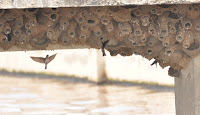It is about 10 km from Tumkur and is one of the two lakes located at the outskirts of Tumkur called Imran Mushtaq Twin Lakes. It is located adjacent to the town Melekote. The two lakes are locally called Melekote Kere and Bheemasandra Kere. We did not plan where to start exactly and ended up reaching the lake bund at its southernmost point by going through Melekote. Roads were narrow but our car made it through safely. We parked on the mud road next to the bund and walked along the canal eastwards and then north after we crossed over the canal at a bridge. This path continues along the lakeside until it reaches the Sewage Treatment plant, at which point we are at Bheemasandra Kere. We walked along the west side of the STP observing the lake all along and backtracked to our starting point along the same path.
Trail type: Muddy walking path in the half circumnavigation we did of the lake. Not sure about the other half but should be the same. The total distance, if we one can go fully around the lake, maybe 4 to 5km. We did about 2 km out and 2 km back.
Facilities: None at the lake. Melekote village is adjacent on the eastern side.
A casual conversation on March 10th with my friend in Tumkur who is an avid bird watcher revealed that both of us were free the following day, which was a public holiday. So, we used that the best way possible, that is to go Bird Watching! The choice was between lake habitat or forest habitat both of which are very good around Tumkur. We settled on a lake in hopes of seeing migrant ducks.
We left Bangalore early morning and reached Tumkur for an early breakfast of their famous Thatte idlis and Dosas. Soon after, we headed towards the lake using Google for guidance. Unfortunately, Maps was not aware of bird-watching spots around the huge lake. It guided us onto open fields and muddy roads which my car was reluctant to go on. Somehow we navigated ourselves back into Melekote village and using my friend's memory and guidance of villagers, we managed to reach the southernmost point of the twin lakes. Not exactly where we had intended. But as with life, it turned out to be excellent giving us a nice surprise, as you will find out.
As soon as we got out of the car, we were greeted by warblers, babblers in the bushes, and cormorants flying overhead. But our attention was drawn towards a wagtail on the paddy fields which we found was a Yellow Wagtail. As we watched it hopping around and wagging its tail, we got the surprise sighting of a Bluethroat male feeding in a small stream alongside the fields. We stood mesmerized at the beautiful colors forming a necklace at its throat (hence the name) and watched its antics for a good 10 to 15 mins before reluctantly starting out for our bird walk.

The muddy trail took us past the point where a man-made bund separates the lakes to get us on Bheemasandra Kere to the north side. Far off we could see a flock of Garganey and another of Spot-billed ducks. At one point along this path, there was a beautiful and serene pool of water which was full of Black-winged Stilts feeding and enjoying themselves. Among them, we could also spot the Wood Sandpiper. Soon we reached a Sewage Treatment Plant (STP).
As we walked in through the gate, my friend directed my attention to underneath the concrete walkways across the STP sections. Wow. It was an intricate network of nests built by the Streak-throated Swallows and a sight to behold. 100s of them were flying around while quickly popping in and out of their mud nests. It was hypnotizing to watch their energetic activity with no letup. Reluctantly, we continued along the STP edge until we reached the north point of the lake to be greeted by the sight of Garganeys and Northern Shovelers sitting like school children in a line on the posts of a submerged fence.
By this time the sun was high. Hot and tired we headed back along the same path to reach our parked car around noon. Along the way, in addition to the birds, we had seen, we got to observe frenzied feeding of the Blue-tailed Bee-eaters. When we reached our car as if on cue, the Bluethroat came out and hopped around the bushes and we could have sworn waved goodbye to us!
It was a great birding outing. As always sad to see some of the human activity close to the lake which is bound to destroy this beautiful habitat and with it the bird diversity. Hopefully, it will be limited and the birds will continue to visit this lake as they escape the harsh winters and provide us the pleasure we experienced that day as our guests for a few months in the year.
Click below for the:
















